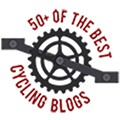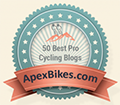Running on Empty
 Mon, February 11, 2013
Mon, February 11, 2013 A cyclist is somewhat unique in that he/she is both the passenger and engine. Like any engine it runs on fuel and when the fuel runs out the engine stops.
The fuel in this case is oxygen and carbohydrates, (Carbs.) and the muscles burn these as the cyclist turns the pedals. Oxygen is taken in automatically, but carbs in the form of the food we eat have to be taken in consciously.
Anyone who has been a cyclist for any length of time probably will have experienced the dreaded “Bonk.” Just as your car engine will splutter and stop when the gas runs out, run out of carbs and you will begin to feel weak, light headed, and the best you can do is creep along at a snail’s pace.
If you are alone and miles from anywhere that has food, you are in big trouble. If you have never experienced the Bonk, believe me it is an experience you would be better off avoiding.
Many of us are riding bikes to lose, or at least maintain a certain weight. Most people talk about carbs when taking on food/fuel, and calories when they are burning it. 1 gram of carbohydrate = 4 calories.
If we burn more calories than we take in we will lose weight. We won't lose weight even if we put in a lot of miles on the bike, if we over compensate our food intake for the amount we are burning.
As we gain fitness our rides become longer; it is no use thinking because we have a “Spare Tire” around our waistline this will sustain us on a long ride, something like the camel’s hump. It doesn’t work that way.
According to this article, we have in our bodies about 300 – 400 grams of carbs that we can draw on as immediate fuel, and riding a bike you are burning at least 100g of carbs per hour.
So we are good for a ride of 3 to 4 hours in duration without eating. If you are planning a longer ride, you need to look on the 300 to 400 carbs that you start out with as a reserve.
 This 3 to 4 hours of available energy is not a precise amount like the capacity of a gas tank; it will vary from one individual to another.
This 3 to 4 hours of available energy is not a precise amount like the capacity of a gas tank; it will vary from one individual to another.
Also a lot depends on the intensity of your ride; the faster you ride, the rate of calorie burn per mile increases because of greater wind resistance. (See the table on the left.)
Not only are you burning more calories per mile, but you are covering more miles per hour, and therefore you could be burning a lot more than 100 calories per hour.
Let’s say you plan to do a 6 or 8 hour ride; you will need to start eating around the first hour, and each half hour after that. The average energy bar is around 40 – 50 carbs, and it is unlikely you will eat a whole one every half hour. (Maybe half a bar.)
You will always be running on a deficit; burning more carbs per hour that you are taking in. Which is why it is important to start eating early and leave the 300 – 400 carbs you start out with as a reserve.
My usual Sunday ride is around 50 miles. I ride a moderate 15 mph average which means I am on the road for 3 1 /2 hours. (Give or take.) Before the ride I eat a bowl of oatmeal with fruit. I usually carry an energy bar with me, just in case. I usually can do this ride without eating.
This bears out what is said it the above linked article, that we are good for 3 to 4 hours. By the end of the ride I am close to being “Bonked” out but not quite. On arriving home I immediately eat something like a Greek Yogurt, and maybe a banana.
Also I find if I get started on my ride early enough that I can be back around noon, I can ride without eating. However, if I get a later start, because possibly it is too cold to start early; I will eat half an energy bar, halfway through the ride. It seems my body is used to having some nourishment around mid-day no matter what.
Rule of thumb is, if the ride is an hour or so you should not need to eat while riding. If it’s over three hours, take an energy bar or a banana or something, just in case. Any ride longer than four hours, plan ahead.
Eat plenty of carbs and drink lots of water the night before and on the morning of the ride. And carry enough food to get you though the number of hours you plan to be on the road. Start eating an hour in, and continue a little at a time throughout the ride.
 Dave Moulton | Comments Off |
Dave Moulton | Comments Off | 





















Reader Comments (11)
What you've written above isn't quite right. Even at moderate to high intensities we burn quite a lot of fat whilst cycling. Yet you don't mention fat anywhere in the article!
I rode for 4.45 hours on Saturday with just a banana and water, then 3.5 hours with no food at all. While this is certainly not a good idea, I maintained the same intensity throughout both rides (upper zone 2 for the first ride and zone 2 plus 30 mins in zone 5 on the second ride) shows that food intake during a ride, while certainly very beneficial, is not strictly necessary all of the time.
Example...
Saturday's ride was 4.35 hours at 220 watts
220 watts = 220 joules per second (0.22 kilojoules per second).
Average rider has a metabolic efficiency of 21-22% (assume mine is 21.5%)
60 seconds in a minute, 60 mins in an hour.
4.2 kilojoules in 1 kiloalorie.
((((0.22*60*60)/21.5)*100)/4.2)*4.5 = 3946.8 kcalories burned
If I only burned carbohydrate during this ride, assuming I have 500g of glycogen stored, at 4 calories per gram I would only have 2000 calories to use (plus the few calories in the banana) before I bonked.
The gut can only absorb about 60g of carbs per hour anyway, so even if I'd eaten during the ride, I would have only taken in around of 1080 calories... this still leaves me about 850 calories short....
220 watts is well withing my endurance zone... the fact is that at what is (for me) such a low intensity, human beings mostly metabolize fat stored in the body during exercise. At this level of effort only a normal everyday amount of food intake is really required, especially if weight loss is a goal. If weight loss is not desired then the extra calories can be replaced before, during and after the ride.
Obviously it would have been better to eat during the ride and I felt very hungry towards the end of the ride, but I get hungry roughly every three hours even when I'm not cycling anyway!
Amazing how times have changed and reading the above I just wonder what times we would have ridden in TTs in the earlys 1940s 1950s IF we had had the knowledge then, we now have? I remember the morning of riding my POB 25 mile tt 58,25 for 25 miles, I had a FULL cooked English brecky rode 20miles to the start with the bike loaded to the gills full kit we called it. Pouring down with rain stripped the bike down rode the 25miles kitted up and rode to the local pub had a pint and god knows what to eat then rode with the club 40miles, back home had a roast beef dindin and then to bed.Did not even know what a Banana was! very scarce after the war.
Is reluctance to eat while riding about riding? Or about eating? No longtime bike rider would argue or dispute Dave's statements. If you are not in agreement with what Dave says, and you refrain from eating while in the saddle, what have you gained? What's in it for you?
Maynard, you've completely missed the point I was making. Which is that steady riding is mostly fueled by fat metabolism. Didn't I make that clear enough?
I'm not reluctant to eat while riding - in fact, far from it. I was just disorganized this weekend.
If you think endurance exercise is wholly fueled by carbohydrate, or you think it's always possible or even necessary to replace all the calories used while cycling by eating while on the bike, then you need to read some basic texts on human biochemistry and athletic performance.
Now you HAVE explained why I can ride steady like I do. I thought it was all the Guiness I drink! tried eating AND drinking once, but thats when I hit the Horse on the trail. But all serious aside I do find that a granoloa bar at rest stops helps. I will be riding the Elephant Rock 80 mile ride in Caste Rock Colorado in June to celebrate my 80th they have rest stops every 20 miles or so and I do find a banana and plenty of water helps. Looking at prices that bike shops etc get for all the energy drinks, are they worth it and does it help? Dave. Happy Birthday or are you keeping the date a secret?
I have bonked once......and that was enough!
Was out on a 50 mile ride, and I did take some food along. It was not supposed to be a tiring ride - just rolling hills. Anyway, I got totally lost, finished off by riding 80'ish miles that day. Bonked about 10 miles before I reached home, and had to struggle on up the hills. The area was mostly unknown to me, so I wasn't able to find anywhere to refuel.
Anyway, once you've bonked it's too late to try and fuel up. It takes about 30 mins for anything I've eaten to become available to my muscles, and that wasn't going to help here.
Since that day I always take along extra food. My solution: Fig Newtons. Bite sized, and full of calories. Energy bars and my body don't like each other. :)
I've bonked several times - it gets worse as I age. The toughest time was coming up Tunitas Creek and about halfway up I started to shake and shiver, nearly not making it to the top of the hill. Never again will I travel without food and water.
But best anti-bonk food I've found are peanuts and raisins - carbs and proteins - lots of 'em.
And Dave, you're right. I can do a three plus hour ride most of the time without an issue. But anything over that . . . . .
Happy Birthday Dave? By the way the weekend of 23 Feb is the NAHDBS Custon bike builders show in Denver. Love to see you there Your one of em or at least in the past
http://www.ploscompbiol.org/article/info%3Adoi%2F10.1371%2Fjournal.pcbi.1000960#pcbi-1000960-g001
Fat vs Carbohydrate Metabolism
Note that even at 100% VO2max fat is still used... even though it's just 5%, the absolute quantity of energy used at VO2max is very high so it's still a large amount of energy.